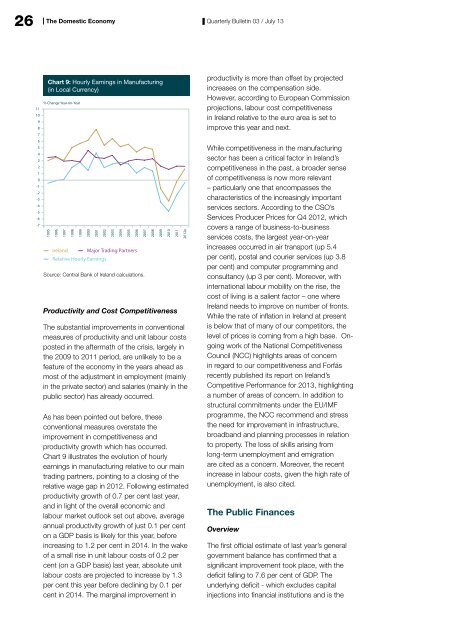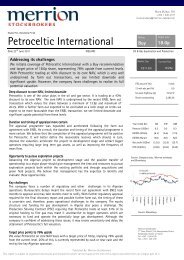Quarterly Bulletin Q3 2013
Quarterly Bulletin Q3 2013
Quarterly Bulletin Q3 2013
You also want an ePaper? Increase the reach of your titles
YUMPU automatically turns print PDFs into web optimized ePapers that Google loves.
26<br />
The Domestic Economy<br />
<strong>Quarterly</strong> <strong>Bulletin</strong> 03 / July 13<br />
11<br />
10<br />
9<br />
8<br />
7<br />
6<br />
5<br />
4<br />
3<br />
2<br />
1<br />
0<br />
-1<br />
-2<br />
-3<br />
-4<br />
-5<br />
-6<br />
-7<br />
Chart 9: Hourly Earnings in Manufacturing<br />
(in Local Currency)<br />
% Change Year-on-Year<br />
1995<br />
1996<br />
1997<br />
1998<br />
1999<br />
2000<br />
2001<br />
2002<br />
2003<br />
2004<br />
2005<br />
2006<br />
2007<br />
2008<br />
2009<br />
2010<br />
2011<br />
2012e<br />
Ireland Major Trading Partners<br />
Relative Hourly Earnings<br />
Source: Central Bank of Ireland calculations.<br />
Productivity and Cost Competitiveness<br />
The substantial improvements in conventional<br />
measures of productivity and unit labour costs<br />
posted in the aftermath of the crisis, largely in<br />
the 2009 to 2011 period, are unlikely to be a<br />
feature of the economy in the years ahead as<br />
most of the adjustment in employment (mainly<br />
in the private sector) and salaries (mainly in the<br />
public sector) has already occurred.<br />
As has been pointed out before, these<br />
conventional measures overstate the<br />
improvement in competitiveness and<br />
productivity growth which has occurred.<br />
Chart 9 illustrates the evolution of hourly<br />
earnings in manufacturing relative to our main<br />
trading partners, pointing to a closing of the<br />
relative wage gap in 2012. Following estimated<br />
productivity growth of 0.7 per cent last year,<br />
and in light of the overall economic and<br />
labour market outlook set out above, average<br />
annual productivity growth of just 0.1 per cent<br />
on a GDP basis is likely for this year, before<br />
increasing to 1.2 per cent in 2014. In the wake<br />
of a small rise in unit labour costs of 0.2 per<br />
cent (on a GDP basis) last year, absolute unit<br />
labour costs are projected to increase by 1.3<br />
per cent this year before declining by 0.1 per<br />
cent in 2014. The marginal improvement in<br />
productivity is more than offset by projected<br />
increases on the compensation side.<br />
However, according to European Commission<br />
projections, labour cost competitiveness<br />
in Ireland relative to the euro area is set to<br />
improve this year and next.<br />
While competitiveness in the manufacturing<br />
sector has been a critical factor in Ireland’s<br />
competitiveness in the past, a broader sense<br />
of competitiveness is now more relevant<br />
– particularly one that encompasses the<br />
characteristics of the increasingly important<br />
services sectors. According to the CSO’s<br />
Services Producer Prices for Q4 2012, which<br />
covers a range of business-to-business<br />
services costs, the largest year-on-year<br />
increases occurred in air transport (up 5.4<br />
per cent), postal and courier services (up 3.8<br />
per cent) and computer programming and<br />
consultancy (up 3 per cent). Moreover, with<br />
international labour mobility on the rise, the<br />
cost of living is a salient factor – one where<br />
Ireland needs to improve on number of fronts.<br />
While the rate of inflation in Ireland at present<br />
is below that of many of our competitors, the<br />
level of prices is coming from a high base. Ongoing<br />
work of the National Competitiveness<br />
Council (NCC) highlights areas of concern<br />
in regard to our competitiveness and Forfás<br />
recently published its report on Ireland’s<br />
Competitive Performance for <strong>2013</strong>, highlighting<br />
a number of areas of concern. In addition to<br />
structural commitments under the EU/IMF<br />
programme, the NCC recommend and stress<br />
the need for improvement in infrastructure,<br />
broadband and planning processes in relation<br />
to property. The loss of skills arising from<br />
long-term unemployment and emigration<br />
are cited as a concern. Moreover, the recent<br />
increase in labour costs, given the high rate of<br />
unemployment, is also cited.<br />
The Public Finances<br />
Overview<br />
The first official estimate of last year’s general<br />
government balance has confirmed that a<br />
significant improvement took place, with the<br />
deficit falling to 7.6 per cent of GDP. The<br />
underlying deficit - which excludes capital<br />
injections into financial institutions and is the




